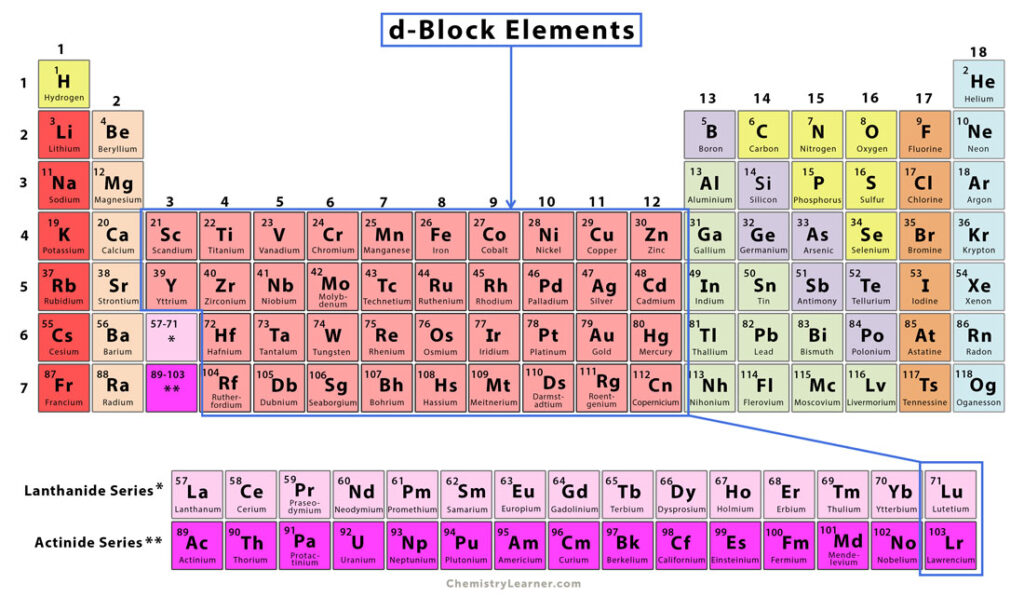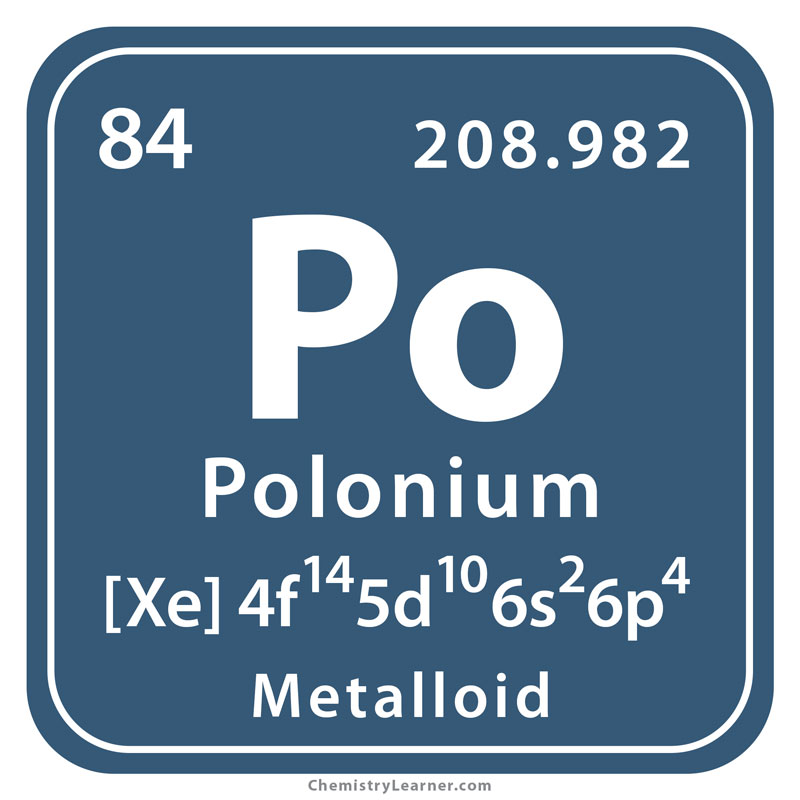d-Block Elements
The elements from Group 3 to Group 12 of the periodic table are collectively called the d-block elements. They are called so because the highest energy subshell, i.e., the subshell where the last electron occupies, is a d subshell. There are 40 d-block elements [1-4].
The d-block elements are also known as transition metals because they transition properties between the s-block elements of Groups 1 and 2 and the p-block elements of Groups 13 to 18.
Electron Configuration
Generally, electrons are fed into orbitals in order of increasing energy until all the electrons have been accommodated. The general valence shell electron configuration of the d-block elements is (n-1)d1-10ns1-2. The electrons fill the d subshell of these elements according to the following rules [1-4].
- Electrons fill atomic orbitals according to their increasing energies (Aufbau principle).
- The electrons fill each orbital first before any orbital gets a second electron (Hund’s rule).
- The 3d and 4s subshells have energy values close to each other. However, 4s is slightly lower than 3d. So, the 4s subshell fills before 3d.
- The d subshell contains five d orbitals and can hold up to 10 electrons.
The valance shell electron configurations of all four series of d-block elements are shown in the following table.
| Period 4 | Sc | Ti | V | Cr | Mn | Fe | Co | Ni | Cu | Zn |
| Electron configuration | 3d1 4s2 | 3d2 4s2 | 3d3 4s2 | 3d5 4s1 | 3d5 4s2 | 3d6 4s2 | 3d7 4s2 | 3d8 4s2 | 3d10 4s1 | 3d10 4s2 |
| Period 5 | Y | Zr | Nb | Mo | Tc | Ru | Rh | Pd | Ag | Cd |
| Electron configuration | 4d1 5s2 | 4d2 5s2 | 4d4 5s1 | 4d5 5s1 | 4d5 5s2 | 4d7 5s1 | 4d8 5s1 | 4d10 | 4d10 5s1 | 4d10 5s2 |
| Period 6 | Lu | Hf | Ta | W | Re | Os | Ir | Pt | Au | Hg |
| Electron configuration | 4f14 5d1 6s2 | 4f14 5d2 6s2 | 4f14 5d3 6s2 | 4f14 5d4 6s2 | 4f14 5d5 6s2 | 4f14 5d6 6s2 | 4f14 5d7 6s2 | 4f14 5d9 6s1 | 4f14 5d10 6s1 | 4f14 5d10 6s2 |
| Period 7* | Lr | Rf | Db | Sg | Bh | Hs | Mt | Ds | Rg | Cn |
| Electron configuration | 5f14 7s2 7p1 | 5f14 6d2 7s2 | 5f14 6d3 7s2 | 5f14 6d4 7s2 | 5f14 6d5 7s2 | 5f14 6d6 7s2 | 5f14 6d7 7s2 | 5f14 6d8 7s2 | 5f14 6d9 7s2 | 5f14 6d10 7s2 |
Note: * The last four electron configurations are predictions only.
Numerous inconsistencies occur in the electron configuration. They are due to:
- The small energy gap between ns and (n-1)d subshells
- Pairing energy for the electron in the s subshell
- Stability of half-filled and completely-filled subshells
The elements having half-filled and completely-filled subshells are generally stable. For example, in Period 4, chromium’s electron configuration is [Ar] 3d5 4s1 instead of [Ar] 3d4 4s2. It has half-filled d and s subshells. Another example is copper, whose electron configuration is [Ar] 3d10 4s1 instead of [Ar] 3d9 4s2. It has completely-filled d and half-filled s subshells. Similar behavior can be observed in molybdenum, silver in Period 4, and gold in Period 5.
d-Block Elements and Transition Metal Chemistry
The partially filled d subshell and the ease at which electrons can be removed from or placed in the d orbitals give rise to several unique chemical properties. These include [1-4]:
- Forming colored compounds
- Behaving as catalyst
- Multiple oxidation states
The 4s electrons are shielded from the atomic nucleus by the 3d electrons. Therefore, the 4s electrons are easier to remove. For example, iron forms Fe2+ and Fe3+ as follows:
Fe: [Ar] 3d6 4s2
Fe2+: [Ar] 3d6…… loses 2 4s electrons and gives a green color
Fe3+: [Ar] 3d5…… loses 2 4s electrons and 1 3d electron and gives a reddish-brown color
And zinc forms colorless Zn2+ ions only
Zn: [Ar] 3d10 4s2
Zn2+: [Ar] 3d10
Here, we can introduce the concept of transition metal. A transition metal is a d-block element that forms at least one stable ion with a partially filled d subshell. Iron is a transition metal. However, the elements in Group 12, like zinc, cadmium, and mercury, are not considered transition metals because their stable ions do not have partially filled d subshells. In Period 4, all elements from Ti to Cu are transition metals. We can say that all transition metals are d-block elements. However, not all d-block elements are transition metals.
All transition metals form complex compounds whose central ion has an oxidation number +2 due to the loss of two electrons from the s subshell. However, the d subshell can also lose electrons resulting in stable ions with higher oxidation numbers. Such a phenomenon is possible because the energy levels of ns and (n-1)d subshells are close. Ions can quickly go from one oxidation state to another by accepting or donating electrons.
Atomic Radius Trend in d-Block Elements
As in the case of the s-block and p-block elements, the size of neutral atoms of the d-block elements gradually decreases from left to right across a period due to an increase in the effective nuclear charge with increasing atomic number. The atomic radius increases down a group due to increasing atomic number. The increase in size between Period 4 and Period 5 is much more significant than between the Period 5 and Period 6 elements [1-4].
Physical Properties
Due to their unique electron configuration, the d-block elements possess unique physical properties that differ from the s-block and p-block elements. These include [1-4]:
- Malleability – the ability to be hammered into flat sheets or drawn into wires
- Ductility – the ability to pull into thin wires
- Good conductors of heat and electricity – valance electrons can move freely, allowing the substance to conduct heat and electricity.
- High-density – atoms are tightly packed
- High melting points – have strong metallic bonds
- High luster – light reflects off the surface reasonably well, making the substance appear bright
- Bright colors – a wide range of colors are produced by them





